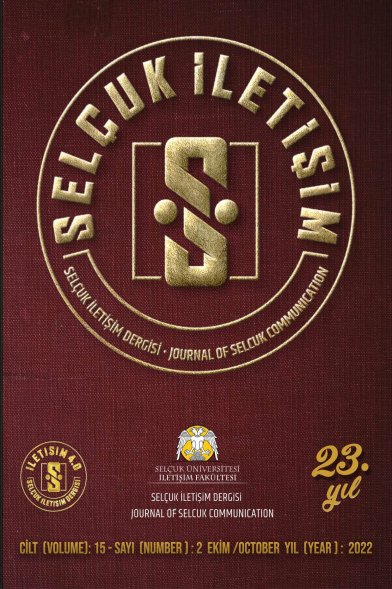TÜRKİYE'DE YÜKSEKÖĞRETİMDE AÇIK VE UZAKTAN ÖĞRENME YÖNTEMİ İLE İLETİŞİM EĞİTİMİ ÜZERİNE DEĞERLENDİRMELER
Ülkemizde üniversite düzeyindeki iletişim eğitimi hem örgün hem de açık ve uzaktan eğitim yöntemleriyle gerçekleştirilmekte, gerek devlet gerekse vakıf üniversitelerindeki iletişim bölümleri sektörün ihtiyaç duyduğu teknik personel ve meslek elemanı yetiştirmeyi amaçlamaktadır. Bu çalışmanın amacı, ülkemizde açık ve uzaktan eğitim sistemiyle verilen iletişim eğitiminin genel yapısını değerlendirmektir. Bu amaçla açık ve uzaktan eğitim sistemiyle hangi programlarda iletişim eğitimi verildiği ve iletişim eğitimi veren programların giriş koşulları, program yeterlilikleri, ders kredileri, mezuniyet koşulları, staj ve ölçme değerlendirme sistemi, öğrenme ortam ve araçları ile destek hizmetlerinin nasıl uygulandığı ortaya konulmuştur. Çalışmanın sonucunda; programlarda program çeşitliliğinin ve uzmanlığın söz konusu olmadığı ve bu programların daha çok genel eğitimler olarak değerlendirilebileceği söylenebilir. İletişim eğitimi aynı zamanda da belirli teknik yeterliliklerin bilinmesini gerektiren bir alandır. Bu nedenle programlarda teknik yeterliliklere ilişkin olanakların açık ve uzaktan eğitimin gereği olarak sanal ortamlarda öğrencilere sunulması önemli görülmektedir.
CONSIDERATIONS ON COMMUNICATION EDUCATION REALISED VIA OPEN AND DISTANCE EDUCATION AT HIGHER EDUCATION SYSTEM IN TURKEY
Communication education in Turkey is realised via both open and distance and formal education systems at higher education level at undergraduate, graduate and postgraduate programs by state and private universities with the aim of training staff needed by the sector. The aim of the study is to put forward the general structure of communication education carried out via open and distance education and evaluate the quality of the education delivered in order to train the required staff via open and distance education systems in Turkey. In order to realise this, the structure of communication education programs at open and distance education systems (preconditions of programs, program outcomes, teaching environments, teaching and testing regulations, student support services and etc.) was evaluated via interviews with these program administrators using qualitative research technique and content analysis method of the web sites of the programs. As result of the study, it can be stated that there are not any program varieties and expertness and these programs can be evaluated as the general training programs. The area of communication education is also an area which requires the knowledge of technical competencies. Therefore, it is crucial to train the students about these technical competencies in virtual environments by force of open and distance education.
___
- Aydın C H (2011) Açık ve Uzaktan Öğrenme, Pegem Akademi, Ankara.
- Cartelli A, Connolly T, Jimoyiannis A Magalhaes H, Maillet K ve Stansfield M (2008) Towards The Development of a New Model for Best Practice and Knowledge Construction in Virtual Campuses, Journalof Information Technology Education, 7, 121-134, www.jite.org/documents/Vol7/JITEv7p121- 134Cartelli 397.pdf, erişim tarihi: 22.01.2016.
- Corbeil J R and Corbeil M E (2015)International Handbook of E-Learning, Volume 1 Theoretical Perspectives and Research, KhanB and Mohamed A (Eds). E-Learning Past, Presentand Future51-64, www.routledgehandbooks.com/doi/ 10.4324/9781315760933.ch3, erişim tarihi: 5.12.2015.
- Çetinsaya G (2014) Büyüme, Kalite, Uluslararasılaşma: Türkiye Yükseköğretimi için Bir Yol Haritası, Yükseköğretim Kurulu Yayınları No: 2014/2, Eskişehir. İşman A(2005) Uzaktan Eğitim, Pegem A Yayıncılık, Ankara.
- Moore M G and Kearsley G (1996) Distance Education: A Systems View, Wadsworth Publishing, Boston.
- Morgan C and O'Reilly M G (1999) Assessing Open and Distance Learners, Kogan Page, London.
- Ngar R, Ngwarai R and Mhute I (2012) Assessment in ODL. Practices, Opportunities, Challenges, International J. Soc. Sci. & Education (3)1, 166-167.
- Özkanal B (2006) Web Sitelerinin Halkla İlişkiler Aracı Olarak Kullanılması: Açıköğretim Sistemine Yönelik Bir Model Önerisi, Yayınlanmamış Doktora Tezi, Selçuk Üniversitesi Sosyal Bilimler Enstitüsü, Konya.
- Puspitasari K A (2010) Student Assessment: Policy and Practice in Asian Distance Education, Sage Pub, New Delhi, 60-65.
- Simonson M, Smaldino S, Albright M and Zvacek S (2012) Teaching And Learning at a Distance: Foundations of Distance Education, Prentice Hall, New Jersey.
- Simpson O (2000) Supporting Students in Open and Distance Learning, Kogan Page,London.
- Thorpe M (1988) Evaluating Open and Distance Learning,Biddles Ltd,Great Britain.
- Tokgöz O (2003) Türkiye'de İletişim Eğitimi: Elli Yıllık Bir Geçmişin Değerlendirilmesi, Kültür ve İletişim, 6(2), 7-32, http://turkoloji.cu.edu.tr/GENEL /tokgoz_iletisim.pdf, erişim tarihi: 24.10.2015.
- Verduin J and Thomas C I (1994)Uzaktan Eğitim: Etkin Uygulama Esasları, İlknur Maviş, (çev)Anadolu Üniversitesi Yayınları, Eskişehir.
- Anadolu Üniversitesi Açıköğretim Fakültesi, http://www.anadolu.edu.tr/ acikog retim, erişim tarihi: 12.11.2015.
- Atatürk Üniversitesi Açıköğretim Fakültesi, http://www.ataaof.edu.tr, erişim tarihi: 12.11.2015.
- İnönü Üniversitesi Uzaktan Eğitim Merkezi, https://inuzem.inonu.edu.tr, erişim tarihi: 14.11.2015.
- İstanbul Üniversitesi Açık ve Uzaktan Eğitim Fakültesi, http://www. auzef.istanbul.edu.tr, erişim tarihi: 14.11.2015.
- Maltepe Üniversitesi Uzaktan Eğitim Birimi, http://muzeb.maltepe.edu.tr, erişim tarihi: 14.11.2015.
- Ondokuz Mayıs Üniversitesi Uzaktan Eğitim Merkezi, http://uzem.omu.edu. tr/erişim tarihi: 14.11.2015.
- Plato Meslek Yüksekokulu, http://www.plato.edu.tr, erişim tarihi: 14.11.2015.
- Radyo ve Televizyon Yayıncılığı Meslek Birliği (2015), www.ratem.org.tr, erişim tarihi: 10.11.2015.
- Reklamcılar Derneği Verileri (2015) http://rd.org.tr/doc/RD_TABLO_2015_ EKIM.pdf, erişim tarihi: 10.11.2015.
- YÖK İstatistikler, 2016.http://www.yok.gov.tr/istatistikler,erişim tarihi: 14.11. 2015.
- Yayın Aralığı: Yılda 2 Sayı
- Başlangıç: 1999
- Yayıncı: Selçuk Üniversitesi İletişim Fakültesi
Sayıdaki Diğer Makaleler
ÇEVRİMİÇİ SİYASAL İLETİŞİM ÜZERİNE BİR LİTERATÜR DEĞERLENDİRMESİ
KURUM ÇALIŞANI BAKIŞ AÇISIYLA KURUMSAL İTİBAR
TELEVİZYON PROGRAMLARINDA ÜRÜN YERLEŞTİRME: “SURVİVOR ALL STAR” ÖRNEĞİ
Emel TANYERİ MAZICI, Nur Banu ATEŞ, Ayşe YILDIRIM
Zühal FİDAN, Zülfiye ACAR ŞENTÜRK
TURİZM DİPLOMASİSİ KAPSAMINDA YER MARKALAMA: TURKEY HOME KAMPANYA ANALİZİ
Berrin ÖZKANAL, Aydın Ziya ÖZGÜR
HALKLA İLİŞKİLERİ POSTKOLONYAL PERSPEKTİFLE YENİDEN DÜŞÜNMEK
MODERN YAŞAMDA DİNİ DEĞERLERİN TELEVİZYONDA TEMSİLİ: “NİHAT HATİPOĞLU İLE İFTAR” PROGRAMI ÖRNEĞİ
